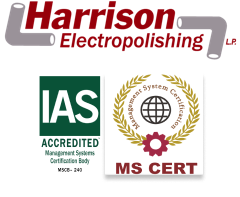- Home
- Applications
- Remove Rouge
Remove Rouge
What is Rouging?
Rouging of stainless steel is a form of corrosion either from external sources or from destruction of the passive layer, leaving a low chromium area. The most common contaminates are iron-oxide, hydroxide or carbonate.
Stainless Steel Rouge Removal
There are three classes of Rouge deposits that can be removed and treated by Harrison EP.
Type 1 rouge originates from an external source. It typically appears as a loosely adhering hydrated iron oxide deposit that ranges in color from orange to red-orange to magenta depending on its distance from its source. The typical source of a Type 1 rouge deposit is metal particles that are generated by erosion or cavitation at pump surfaces. Once loose, these particles then oxidize in the solution and are deposited on other surfaces. This iron oxide deposit may be removed (or de-rouged) by wiping or, more thoroughly, by passivation and electropolishing.
Type 2 rouge forms as the surface below the rouge coloration oxidizes. Type 2 rouge appears as a rust color deposit or blister that, when pried off, may reveal a bright silver, active stainless steel surface. This type of rouge is generally caused by the presence of chlorides and is more likely to appear on unpassivated surfaces. Type 2 rouge cannot be removed by wiping, rather by mechanical polishing, acid cleaning (pickling), or electropolishing.
Type 3 rouge is black and originates in the presence of high temperature steam. Analysis shows that Type 3 rouge is iron sesquioxide, also known as magnetite. If originating from an electropolished surface, Type 3 rouge should appear glossy black and should be tightly adherent and stable. If forming on unpassivated, mechanically polished surfaces, it may appear powdery black and may easily slough-off. Type 3 de-rouging can be accomplished chemically and by mechanical polishing or electropolishing.
Reference:
J.C Tverberg, "Rouging of Steel: Why Good Stainless Steel Turns Red," Flow Control, March 2003, pp18-24
INDUSTRY STANDARDS
-
ASME B46.1

